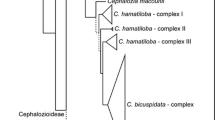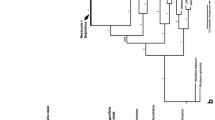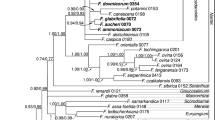Abstract
ITS and ETS-based sequence analyses of 29 Neolitsea, six Actinodaphne and five outgroup `core' Laureae taxa show that Neolitsea is monophyletic with two large subclades, whereas most of the sampled Actinodaphne are paraphyletic below it. Inflorescence features appear to be among the more reliable morphological characters for explaining relationships between Neolitsea and other genera within the `core' Laureae, with the Neolitsea/Actinodaphne clade defined by inflorescences lacking vegetative terminal buds in the main axis. Although the relationships within Neolitsea are still poorly resolved, there is enough structure to suggest that the genus seems to divide into two groups based on fruit shape: elliptic or ovoid, versus globose, although more evidence (both molecular and morphological) and wider taxon sampling are required to confirm this.
Similar content being viewed by others
References
Allen CK (1938). Studies in the Lauraceae. I. Chinese and Indo-Chinese Species of Litsea, Neolitsea and Actinodaphne. Ann Missouri Bot Gard 25: 361–434
Baldwin BG (1992). Phylogenetic utility of the internal transcribed spacers of nuclear ribosomal DNA in plant: an example from the Compositae. Molec Phylogenet Evol 1: 3–16
Baldwin BG and Markos S (1998). Phylogenetic utility of the external transcribed spacer (ETS) of 18S-26S rDNA: congruence of ETS and ITS Trees of Calycadenia (Compositae). Molec Phylogenet Evol 10: 449–463
Baldwin BG, Sanderson MJ, Porter JM, Wojciechowski MF, Campbell CS, Donoghue MJ, Soltis PS, Kuzoff RK, Ko SC, O'Kane SL Jr, Schaal BA, Liu ZL, Sinclair JB, Fangan BM, Stedje B, Stabbetorp OE, Jensen ES, Jakobsen KS, Mes THM and Hart HT (1995). The ITS region of nuclear ribosomal DNA: A valuable source of evidence on angiosperm phylogeny. Ann Missouri Bot Gard 82: 247–277
Barrett M, Donoghue MJ and Sober E (1991). Against consensus. Syst Zool 40: 486–493
Bena G, Prosperi JM, Lejeune B and Olivieri I (1998). Evolution of annual species of the genus Medicago: a molecular phylogenetic approach. Molec Phylogenet Evol 9: 552–559
Bentham G (1880). Laurineae. In: Bentham, G and Hooker, JD (eds) Genera Plantarum, vol 3, pp 146–168. L. Reeve, London
Buckler ES and Holtsford TP (1996). Zea systematics: ribosomal ITS evidence. Molec Biol Evol 13: 612–622
Buckler ES, Ippolito A and Holtsford TP (1997). The evolution for ribosomal DNA: divergent paralogues and phylogenetic implications. Genetics 145: 821–832
Bull JJ, Huelsenbeck JP, Cunningham CW, Swofford DL and Wadell PJ (1993). Partitioning and combining data in phylogenetic analysis. Syst Biol 42: 384–397
Chanderbali AS, van der Werff H and Renner SS (2001). Phylogeny and historical biogeography of Lauraceae: evidence from the chloroplast and nuclear genomes. Ann Missouri Bot Gard 88: 104–134
Cunningham CW (1997). Can tree incongruence tests predict when data should be combined?. Molec Biol Evol 14: 733–740
De Queiroz A, Donoghue MJ and Kim J (1995). Separate versus combined analysis of phylogenetic evidence. Ann Rev Ecol Syst 26: 657–681
Dowton M and Austin AD (2002). Increased congruence does not necessarily indicate increased phylogenetic accuracy – the behaviour of the incongruence length difference test in mixed-model analyses. Syst Biol 51: 19–31
Doyle JJ and Doyle JS (1987). A rapid DNA isolation procedure for small quantities of fresh leaf tissue. Phytochem Bull 19: 11–15
Farris JS, Källersjö M, Kluge AG and Bult C (1995). Testing significance of incongruence. Cladistics 10: 315–319
Gentry AH (1988). Changes in plant community diversity and floristic composition on environmental and geographical gradients. Ann Missouri Bot Gard 75: 1–34
Good L, Intine RVA and Nazar RN (1997). Interdependence in the processing of ribosomal RNAs in Schizosaccharomyces pombe. J Molec Biol 273: 782–788
Hall TA (1999). BioEdit: a user-friendly biological sequence alignment editor and analysis program for Windows 95/98/NT. Nucl Acids Symp Series 41: 95–98
Hitchen J, Ivakine E, Melekhovets YF, Lalev A and Nazar RN (1997). Structural features in the 3′ external transcribed spacer affecting intragenic processing of yeast rRNA. J Molec Biol 274: 481–490
Huelsenbeck JP and Ronquist F (2001). MrBayes: Bayesian inference of phylogenetic trees. Bioinformatics 17: 754–755
Huelsenbeck JP, Ronquist F, Nielsen R and Bollback JP (2001). Evolution – Bayesian inference of phylogeny and its impact on evolutionary biology. Science 294: 2310–2314
Hyland BPM (1989). A revision of Lauraceae in Australia (excluding Cassytha). Austral Syst Bot 2: 135–367
Klücking EP (1987). Leaf venation patterns, vol 2. Lauraceae. J Cramer, Berlin
Kluge AJ (1989). A concern for evidence and a phylogenetic hypothesis of relationships among Epicrates (Boidae, Serpentes). Syst Zool 38: 7–25
Kostermans AJGH (1957). Lauraceae. Pengumuman Balai Besar Penjelidikan Kehutanan Indonesia 57: 1–64
Lanyon SM (1993). Phylogentic frameworks: towards a firmer foundation for the comparative approach. Bot J Linn Soc 49: 45–61
Li H-W (1985). Parallel evolution in Litsea and Lindera of Lauraceae. Acta Bot Yunnan 7: 129–135
Li H-W, Pai PY, Lee SK, Wei FN, Wei YT, Yang YC, Huang PH, Tsui HP, Shia ZD and Li JL (1984). Lauraceae. In: Li, H-W (eds) Flora of Reipublicae Popularis Sinicae, vol 31. Science Press, Beijing
Li J and Christophel DC (2000). Systematic relationships within the Litsea complex (Lauraceae): a cladisitic analysis based on morphological and leaf cuticle data. Austral Syst Bot 13: 1–13
Li J, Christophel DC, Conran JG and Li H-W (2004). Phylogenetic relationships within the Litsea complex (Lauraceae) inferred from sequences of the chloroplast gene matK and nuclear ribosomal DNA ITS regions. Pl Syst Evol 246: 19–34
Li Z-M, Li J and Li X-W (2006). Polyphyly of the genus Actinodaphne (Lauraceae) inferred from the analyses of nrDNA ITS and ETS sequences. Acta Phytotax Sinica 44: 272–285
Liao JC (1988). The taxonomic revision of the family Lauraceae in Taiwan. Mem Coll Agric Natl Taiwan Univ 22: 16–18 [Chinese with English summary]
Maddison WP and Maddison DR (1996). MacClade Version 3.06. Sinauer Assoc Inc Publ, Sunderland
Merrill ED (1906). Neolitsea (Benth.) Merr. Philippine J Sci 1 (Suppl.): 56–57
Miyamoto MM and Fitch WM (1995). Testing species phylogenies and phylogenetic methods with congruence. Syst Biol 44: 64–76
Musters W, Boon K, van der Sande CAFM, van Heerikhuizen H and Planta RJ (1990). Functional analysis of transcribed spacers of yeast ribosomal DNA. EMBO J 9: 3989–3996
Nixon KC (2002). WinClada Version 1.00.08. Published by the author, Ithaca
Nylander JAA, Ronquist F, Huelsenbeck JP and Nieves-Aldrey JL (2004). Bayesian phylogenetic inference of combined data. Syst Biol 53: 47–67
Posada D and Crandall KA (1998). Modeltest: testing the model of DNA substitution. Bioinformatics 14: 817–818
Rohwer JG (1993). Lauraceae. In: Kubitzki, K, Rohwer, JG and Bittrich, V (eds) The families and genera of vascular plants, vol 2, pp 366–391. Springer, Berlin
Rohwer JG (2000). Toward a phylogenetic classification of the Lauraceae: evidence from matK sequences. Syst Bot 25: 60–71
Swofford DL (2002). PAUP*. Phylogenetic Analysis Using Parsimony (* and Other Methods), Version 4.0b10. Sinauer and Associates, Sunderland
Thompson JD, Gibson TJ, Plewniak F, Jeanmougin F and Higgins DG (1997). The ClustalX windows interface: flexible strategies for multiple sequence alignment aided by quality analysis tools. Nucl Acids Res 24: 4876–4882
Tsui HP (1987). A study on the system of Lindera. Acta Phytotax Sinica 25: 161–171
van der Werff H (2001). An annotated key to the genera of Lauraceae in the Flora Malesiana region. Blumea 46: 125–140
Werff H and van der Richter HG (1996). Toward an improved classification of Lauraceae. Ann Missouri Bot Gard 83: 409–418
White TJ, Bruns TD, Lee SB and Taylor JW (1990). Amplification and direct sequencing of ribosomal RNA genes and the internal transcribed spacer in fungi. In: Innis, MA, Gelfand, GH, Sninsky, JJ, and White, TJ (eds) PCR – Protocols and applications – A laboratory manual, pp 315–322. Academic, San Diego
Author information
Authors and Affiliations
Corresponding author
Rights and permissions
About this article
Cite this article
Li, L., Li, J., Conran, J. et al. Phylogeny of Neolitsea (Lauraceae) inferred from Bayesian analysis of nrDNA ITS and ETS sequences. Plant Syst. Evol. 269, 203–221 (2007). https://doi.org/10.1007/s00606-007-0580-8
Received:
Accepted:
Published:
Issue Date:
DOI: https://doi.org/10.1007/s00606-007-0580-8




